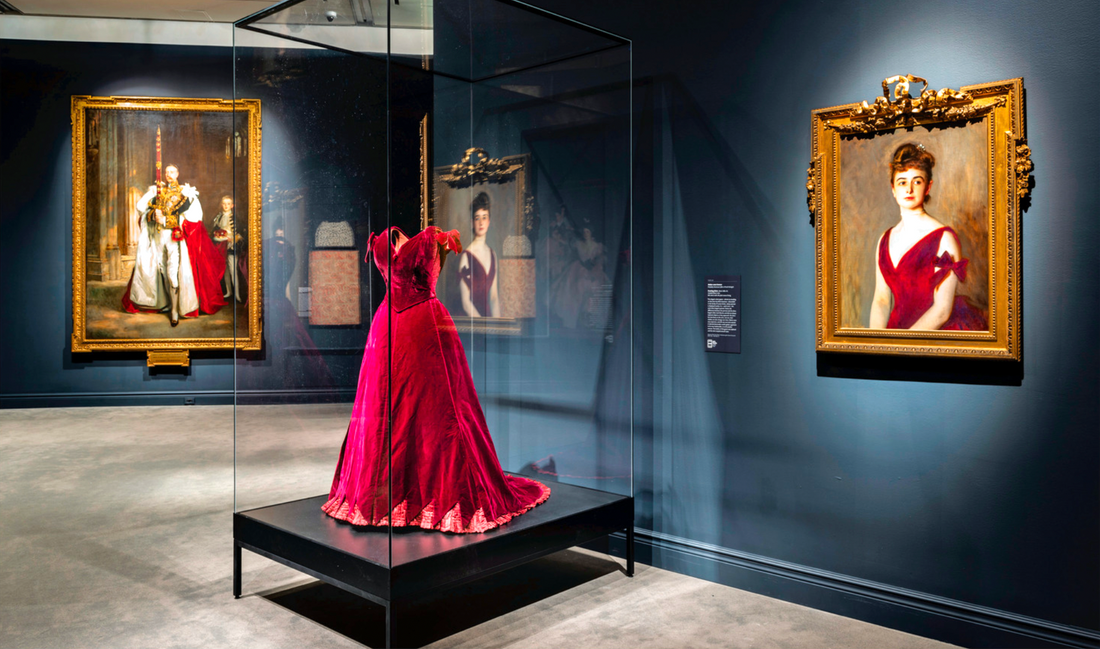
Fashioned by Sargent
Fashioned by Sargent now on display at Tate Britain under the title, Sargent and Fashion, celebrates his striking portrait paintings. Sargent used fashion as a powerful tool to express identity and personality. He regularly chose the outfits of his collaborators or manipulated their clothing. This innovative use of costume was central to his artwork – for example, tugging a heavy coat tighter around a man to emphasise his figure or letting a dress strap sensuously slip from a women's shoulder.
We look back at Kate Cavendish's review of the Museum of Fine Art Boston's display of Fashioned by Sargent and urge you to see Sargent and Fashion before it closes at Tate Britain on 7 July 2024.
Fashioned by Sargent: a review by Kate Cavendish
In Edith Wharton’s Custom of the Country, a great fuss is made over Mrs. Undine Spragg Marvell as she poses for a portrait by Mr. Claud Walsingham Popple: “She was dressed for the sitting in something faint and shining, above which the long curves of her neck looked dead white in the cold light of the studio; and her hair, all a shadowless rosy gold, was starred with a hard glitter of diamonds.” This fictional description, from the 1913 novel, may well have alluded to works by John Singer Sargent, who flourished as a portrait painter in the 1880s. An intimate exhibit at the Museum of Fine Arts, Boston, takes viewers into those sittings by way of the subjects’ attire: Fashioned by Sargent explores the clothing Sargent painted, complemented by displays of the actual (or closely related) garments in the paintings. Part of that exploration involves learning how Sargent manipulated the clothing to produce a desired effect: these portraits were not of fashion but were, as the title indicates, fashioned by the artist himself. The opening painting and garment illustrate this beautifully. Located in a gallery painted a deep pink-brown, like a puff of rouge, Lady Sassoon’s black taffeta opera cloak from the House of Worth stands beside her portrait.
 Image: Installation with woman’s evening dress, House of Worth, French, about 1895, silk damask. Pair of women’s shoes, L. Perchellet, French, 1895, Silk satin, leather, sequins and beads. Dress, House of Worth, French, about 1880 pearl-embroidered white bengaline. Image above: Installation with evening dress, about 1887-1902, silk velvet with silk plain weave lining and portrait of Mrs. Charles E. Inches (Louise Pomeroy), John Singer Sargent, 1887, oil on canvas, 86 x 60 cm.
Image: Installation with woman’s evening dress, House of Worth, French, about 1895, silk damask. Pair of women’s shoes, L. Perchellet, French, 1895, Silk satin, leather, sequins and beads. Dress, House of Worth, French, about 1880 pearl-embroidered white bengaline. Image above: Installation with evening dress, about 1887-1902, silk velvet with silk plain weave lining and portrait of Mrs. Charles E. Inches (Louise Pomeroy), John Singer Sargent, 1887, oil on canvas, 86 x 60 cm.
We look back at Kate Cavendish's review of the Museum of Fine Art Boston's display of Fashioned by Sargent and urge you to see Sargent and Fashion before it closes at Tate Britain on 7 July 2024.
Fashioned by Sargent: a review by Kate Cavendish
In Edith Wharton’s Custom of the Country, a great fuss is made over Mrs. Undine Spragg Marvell as she poses for a portrait by Mr. Claud Walsingham Popple: “She was dressed for the sitting in something faint and shining, above which the long curves of her neck looked dead white in the cold light of the studio; and her hair, all a shadowless rosy gold, was starred with a hard glitter of diamonds.” This fictional description, from the 1913 novel, may well have alluded to works by John Singer Sargent, who flourished as a portrait painter in the 1880s. An intimate exhibit at the Museum of Fine Arts, Boston, takes viewers into those sittings by way of the subjects’ attire: Fashioned by Sargent explores the clothing Sargent painted, complemented by displays of the actual (or closely related) garments in the paintings. Part of that exploration involves learning how Sargent manipulated the clothing to produce a desired effect: these portraits were not of fashion but were, as the title indicates, fashioned by the artist himself. The opening painting and garment illustrate this beautifully. Located in a gallery painted a deep pink-brown, like a puff of rouge, Lady Sassoon’s black taffeta opera cloak from the House of Worth stands beside her portrait.
 Image: Installation with woman’s evening dress, House of Worth, French, about 1895, silk damask. Pair of women’s shoes, L. Perchellet, French, 1895, Silk satin, leather, sequins and beads. Dress, House of Worth, French, about 1880 pearl-embroidered white bengaline. Image above: Installation with evening dress, about 1887-1902, silk velvet with silk plain weave lining and portrait of Mrs. Charles E. Inches (Louise Pomeroy), John Singer Sargent, 1887, oil on canvas, 86 x 60 cm.
Image: Installation with woman’s evening dress, House of Worth, French, about 1895, silk damask. Pair of women’s shoes, L. Perchellet, French, 1895, Silk satin, leather, sequins and beads. Dress, House of Worth, French, about 1880 pearl-embroidered white bengaline. Image above: Installation with evening dress, about 1887-1902, silk velvet with silk plain weave lining and portrait of Mrs. Charles E. Inches (Louise Pomeroy), John Singer Sargent, 1887, oil on canvas, 86 x 60 cm.Want to read more of this article?
We are proud to be a subscriber-funded publication with members in 185 countries. We know our readership is passionate about textiles, so we invite you to help us preserve and promote the stories, memories, and histories that fabric holds. Your support allows us to publish our magazine, and also ‘what's on’ information, and subscription interviews, reviews, and long-read articles in our online blog.
ALREADY A SUBSCRIBER? CLICK HERE TO ACCESS CONTENT

